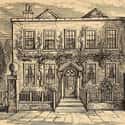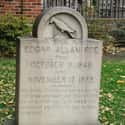-
(#6) Poe Was Disowned
When John Allan got word from the Army that Edgar had secretly been an enlisted man for two years, he was angered and appalled. Such a development was not only a degrading step for any member of upper-class society, it also reflected poorly on Allan, who may have been perceived as forcing such an act of desperation. Allan refused to speak to Poe at first but reconciled with him at his wife's funeral. But one incident would permanently sever their tenuous relationship.
Poe had agreed to pay a certain Sergeant Samuel Graves, to would serve out the rest of Poe's enlistment in the military so he could attend West Point instead. When it came time to pay up, Poe gave him the runaround and eventually suggested that he would try to get money from his guardian, John Allan, but that this would take longer because "Mr. Allan is not very often sober."
In 1830, Graves personally confronted Allan and showed him the letter. The debt was paid off and Allan subsequently refused to answer any of Poe's missives, no matter how desperate or apologetic. Allan got remarried to the mother of his two illegitimate children and fathered his own legitimate son and heir.
Poe never gave up on some sort of reconciliation, though. In 1834, when he heard Allan was on his deathbed, Poe visited his home, forced his way past Allan's wife, and entered his guardian's bedroom. As he approached Allan's bedside, Allan threatened to beat him with his cane and ordered him out of his sight. Poe was not even mentioned in John Allan's will.
-
(#15) Poe's Last Poem, 'Annabel Lee,' Foretold His Eternal Destiny
"Annabel Lee" was the last poem composed by Edgar Allan Poe, completed in May 1849. Unsure of his future and hoping to ensure its publication, Poe distributed the poem to three different individuals. The first to publish it was Rufus Griswold in his obituary, which appeared two days after Poe's death.
Out of economic necessity, Virginia Clemm Poe had been buried in the Bronx cemetery plot of Poe's landlord in 1847. In 1883, this cemetery was in the process of demolition when a journalist and Poe biographer, William Gill, claimed to have retrieved Virginia's remains from the cemetery's sexton. After getting in touch with Poe's relatives in Baltimore, the remains were reburied next to Edgar Allan Poe in January 1885, fulfilling the strange prophecy that Poe had alluded to in the last stanza of "Annabel Lee":
For the moon never beams, without bringing me dreams
Of the beautiful Annabel Lee;
And the stars never rise, but I feel the bright eyes
Of the beautiful Annabel Lee;
And so, all the night-tide, I lie down by the side
Of my darling—my darling—my life and my bride,
In the sepulchre there by the sea,
In her tomb by the side of the sea.The Westminster Cemetery is only a few blocks away from Baltimore's Inner Harbor and Maryland's Chesapeake Bay.
-

(#12) The Details Of Poe's Death Remain A Mystery
Edgar Allan Poe boarded a steamboat in Richmond, VA on September 27, 1849, bound for New York City. In an attempt to win the hand of his latest intended bride, Sarah Royster Shelton, Poe had sworn a vow of abstinence. Most likely, Poe broke this vow of abstinence when the ship arrived at a scheduled stop in Baltimore on September 28, 1849.
It was not until October 3 that an individual named Joseph Walker sent a letter to an acquaintance of Poe's, Dr. Joseph Snodgrass, stating that Poe was found in a Baltimore gutter incoherent and needed help. When Snodgrass arrived on the scene outside of a local tavern, he took one look at Poe's vacant eyes and totally unkempt condition and immediately got him admitted to a hospital. Poe lingered for four days before dying on October 7, 1849. He remained incoherent and was never able to explain his circumstances to his attending physician, Dr. John Moran, the only person to interact with him in the confined area where Poe died.
Unfortunately, Moran only added to the confusion of Poe's last days by giving numerous paid, dramatic lectures and newspaper accounts with varying descriptions, all of them quite histrionic and unbelievable. The cause of Poe's death has historically ranged from rabies to a fatal beating inflicted by Sarah Royster Shelton's two brothers who had followed him to Baltimore. It is fitting that the inventor of the modern detective mystery story died himself under circumstances that still remain mysterious.
-
(#9) 'The Raven' Made Poe An Overnight Sensation But Still Left Him Broke
"The Raven," a narrative poem by Edgar Allan Poe, first appeared in January 1845. This tale of a man despondent over a lost love and his perhaps imagined bizarre interaction with a remarkable creature brought Poe worldwide popularity. Poe had built a solid reputation as a critic and his fiction was modestly successful, but this poem made him a literary celebrity. "
"The Raven" was republished in numerous newspapers and anthologies and caused the publication of two separate volumes of Poe prose and poetry. Children would follow him on the street shouting the word "Nevermore," and for the first time, Poe was welcomed into the most exclusive salons of New York society.
Although it brought fame, Poe was paid no more than $15 for the poem and possibly only $9. He earned $120 in royalties for the newly published editions but got nothing after borrowing $135 as an advance. In the entire year of 1845, he earned approximately $550, and of that, he owed $150 to individuals who lent him money to buy out his two partners at the Broadway Journal in October 1845. Poe believed he could make the publication profitable if he ran it himself. The journal was out of business by January 1846 and Poe was now not only broke, he was unemployed. He would never obtain another salaried position again.
-
(#11) Poe Proposed To Two Different Women In The Last Year Of His Life
Once Poe's wife died, Poe seems to have become determined to lift himself out of poverty by marrying into wealth or at least respectability. After exchanging letters and poetry for months with a widowed writer and poet named Sarah Helen Whitman, in September 1848, Poe abruptly showed up at her Providence, RI, home, declared his eternal love and forcefully proposed an immediate marriage. He returned to the Bronx where he received her letter of rejection but he journeyed to Providence again in October, reiterating his proposal. He then left for Lowell, MA, and the home of the family of Annie Richmond, another love interest who also happen to be married.
Poe would return to Sarah Whitman's home several times in November and December, actually getting her to agree to a Christmas Day wedding. The hostility of Sarah's mother, who legally placed the family estate out of any potential reach of Edgar, and Poe's drinking, despite a vow of abstinence, ultimately scuttled the relationship. Unbeknownst to Whitman, Poe was also romancing another woman, Sarah Royster Shelton, an old flame from Poe's childhood. In Richmond in 1848, attempting to raise money for a journal he would edit, Poe showed up at Shelton's house unannounced, the two having not seen each other since they were teenagers.
Poe spent much of the first half of 1849 in Virginia on lecture tours and attempted fundraising for his proposed journal and romancing Shelton, again proposing marriage continuously. Despite Sarah's children's objection and her deceased husband's will calling for a three-quarter forfeit of his estate in the event of remarriage, Sarah told Edgar she'd think it over while, in September 1849, he went to New York. She found out about Poe's October 7, 1849, death by reading about it in the newspaper.
-
(#14) Even In Death, Poe Was Still Victimized By Bizarre Bad Luck
After his death in 1849, Edgar Allan Poe was hastily buried in an unmarked grave in the Poe family plot at Baltimore's Westminster Cemetery, in a ceremony attended by a few distant relatives and a total of seven individuals. By 1860, Maria Clemm had heard rumors that Poe's grave was unmarked and covered with weeds. She wrote to Poe's most prominent relative in Baltimore, Neilson Poe, expressing her concern. Neilson decided to pay for a marble headstone but the monument, although completed, was destroyed in a freight yard by a runaway train.
With the onset of the Civil War and higher priorities, Poe's grave went unmarked until 1865, when a Baltimore teacher named Sara Sigourney Rice began a fundraising drive within the city's school system. She encouraged schoolchildren to collect pennies and adults to contribute additional donations. By 1871, only half the amount necessary for an appropriate monument had been collected.
In 1874, George W. Childs, the prominent Philadelphia publisher of the Philadelphia Public Ledger, agreed to contribute the remainder. Poe, his wife Virginia, and his aunt, Maria Clemm, were exhumed from their graves and moved to their present-day location beneath an appropriately formal monument.
New Random Displays Display All By Ranking
About This Tool
Our data comes from Ranker, If you want to participate in the ranking of items displayed on this page, please click here.





